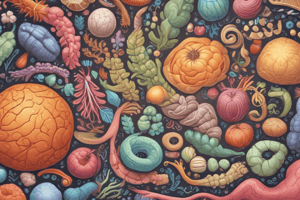Podcast
Questions and Answers
What are the building blocks of all carbohydrates?
What are the building blocks of all carbohydrates?
- Monosaccharides (correct)
- Disaccharides
- Polysaccharides
- Oligosaccharides
Which type of carbohydrates contain hundreds or even thousands of individual sugars?
Which type of carbohydrates contain hundreds or even thousands of individual sugars?
- Oligosaccharides
- Polysaccharides (correct)
- Disaccharides
- Monosaccharides
What type of bond joins two monosaccharide units to form disaccharides?
What type of bond joins two monosaccharide units to form disaccharides?
- Covalent bond (correct)
- Polar bond
- Hydrogen bond
- Ionic bond
Which term is used for larger carbohydrate structures containing 3–9 monosaccharide units?
Which term is used for larger carbohydrate structures containing 3–9 monosaccharide units?
If a polysaccharide is composed of entirely a single type of monomer unit, it is classified as a:
If a polysaccharide is composed of entirely a single type of monomer unit, it is classified as a:
Which classification of polysaccharides contains multiple types of monomers?
Which classification of polysaccharides contains multiple types of monomers?
What are the three main categories of glycoconjugates?
What are the three main categories of glycoconjugates?
What type of carbohydrates are primarily involved in proteoglycans?
What type of carbohydrates are primarily involved in proteoglycans?
Which amino acids can sugars be attached to in glycoproteins?
Which amino acids can sugars be attached to in glycoproteins?
Which class of glycoconjugates involves macromolecular complexes primarily containing GAGs?
Which class of glycoconjugates involves macromolecular complexes primarily containing GAGs?
What is the main type of carbohydrate linkage in lipoproteins?
What is the main type of carbohydrate linkage in lipoproteins?
What is a key function of complex carbohydrates forming glycoconjugates?
What is a key function of complex carbohydrates forming glycoconjugates?
Flashcards are hidden until you start studying
Study Notes
Complex Carbohydrates
Complex carbohydrates are long chains of sugar molecules called polysaccharides. These chains can contain hundreds or even thousands of individual sugars, making them more complex compared to simple carbohydrates like fructose or glucose. They play several roles within our bodies, from providing energy to helping form cellular structures. In this article, we will explore the structure of complex carbohydrates and their classification into glycoconjugate classes.
Structure
The building blocks of all carbohydrates are monosaccharides, which consist of one carbon atom connected by single bonds to four other atoms (usually hydrogen, oxygen, sulfur, or nitrogen). Most commonly found monosaccharides are glucose, galactose, mannose, xylose, ribose, and fructose. Monosaccharides combine together to make disaccharides, which have two monosaccharide units joined together with a covalent bond between carbon atoms. Disaccharides further connect through longer strings to create larger structures known as oligosaccharides containing 3–9 monosaccharide units. Oligosaccharides can continue growing until they become polysaccharides, which typically consist of many hundred monosaccharide units linked end-to-end.
Polysaccharides are classified as homopolymers if they are composed entirely of a single type of monomer unit such as starch, or heteropolymers if multiple types of monomers are present such as in chitin and hyaluronic acid. Some examples of these polysaccharides include amylase, dextran, cellulose, and peptidoglycan.
Glycoconjugate Classes
Glycoconjugates are biologically active compounds consisting of both protein and carbohydrate components. They fall under three main categories: glycoproteins, proteoglycans, and lipoproteins. Each is characterized by its unique properties and functions.
-
Glycoproteins: These are proteins that carry sugars attached directly or indirectly to specific amino acids (asparagine, serine, threonine) via chemical linkages. Examples of glycoproteins include enzymes, hormones, and blood clotting factors. Glycosylation plays crucial roles in determining the stability, solubility, folding efficiency, secretion, immune response, and clearance rate of glycoproteins. It also affects their biological activity and interactions with receptors, antibodies, and complement regulatory proteins.
-
Proteoglycans: These are macromolecular complexes primarily involving glycosaminoglycans (GAGs), linear polymeric carbohydrates made up mainly of repeating disaccharide units. Proteoglycans are integral components of extracellular matrices and function in various processes including cell growth, differentiation, migration, tissue repair, and maintenance of organ shape and integrity. Key members of this class are agrin, brevican, decorin, fibromodulin, lumican, perlecan, biglycan, heparan sulfate proteoglycan, versican, and neurocan.
-
Lipoproteins: These are glycolipids, where carbohydrate moieties are linked to phospholipid backbones by esterification to fatty acids. Lipoproteins have crucial roles in cell surface recognition events involved in organogenesis, embryogenesis, and metastasis. An example of a glycolipid is ganglioside GM 1.
In summary, complex carbohydrates, particularly those forming glycoconjugates, serve vital roles in maintaining structural integrity, facilitating intercellular communication, and regulating numerous biological activities. Their complexity enables the precise tailoring required for specialized functions across diverse physiological contexts.
Studying That Suits You
Use AI to generate personalized quizzes and flashcards to suit your learning preferences.




